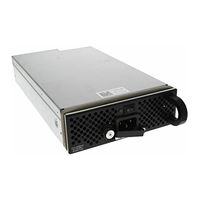Dell TeraScale E1200i Manuals
Manuals and User Guides for Dell TeraScale E1200i. We have 1 Dell TeraScale E1200i manual available for free PDF download: Configuration Manual
Dell TeraScale E1200i Configuration Manual (1262 pages)
FTOS Configuration Guide FTOS 8.4.2.7 E-Series TeraScale, C-Series, S-Series (S50/S25)
Table of Contents
-
-
Objectives33
-
Audience33
-
Conventions34
-
-
-
-
5 802.1Ag
79-
Ethernet CFM79
-
-
6 802.3Ah
93-
-
Remote Loopback103
-
-
7 802.1X
109-
Enabling 802.1X112
-
-
Overview133
-
Cam Optimization136
-
Test Cam Usage136
-
-
Established Flag146
-
-
IP Prefix Lists153
-
ACL Resequencing157
-
Route Maps160
-
-
-
How BFD Works170
-
-
-
Route Reflectors209
-
Confederations210
-
BGP Attributes211
-
Weight214
-
Local Preference214
-
Origin215
-
Next Hop217
-
Debugging BGP267
-
Capturing Pdus269
-
PDU Counters271
-
-
CAM Profiles282
-
Microcode284
-
Boot Behavior286
-
CAM Allocation289
-
Test CAM Usage290
-
View CAM Usage292
-
CAM Optimization298
-
-
-
Archived Files301
-
-
-
-
Option 82322
-
DHCP Snooping322
-
-
-
Show Inventory356
-
FTSA Policies357
-
Debugging FTSA371
-
-
-
RPM Redundancy380
-
-
Hitless Behavior389
-
Graceful Restart390
-
Warm Upgrade393
-
-
-
Configuring IGMP408
-
Adjusting Timers410
-
IGMP Snooping412
-
Interfaces
415-
Interface Types416
-
Null Interfaces427
-
-
-
Interface Range440
-
-
Add Ranges442
-
-
Link Dampening448
-
Port-Pipes454
-
-
Ipv4 Addressing
463-
IP Addresses463
-
Icmp475
-
UDP Helper476
-
-
Ipv6 Addressing
483-
Ipv6 Headers485
-
Addressing488
-
Icmpv6492
-
Qos for Ipv6494
-
Ipv6 Multicast495
-
-
Telnet with Ipv6499
-
SNMP over Ipv6500
-
Show Ipv6 Routes502
-
-
IS-IS Addressing508
-
-
Layer
559-
-
NIC Teaming569
-
-
Configuring FEFD578
-
Debugging FEFD580
-
-
Optional Tlvs585
-
Management Tlvs585
-
-
Configuring LLDP591
-
Enabling LLDP592
-
Advertising Tlvs592
-
Debugging LLDP598
-
-
MLD Version 1605
-
MLD Version 2607
-
Enabling MLD608
-
Debug MLD611
-
-
Clear MLD Groups611
-
-
MLD Snooping611
-
Mldv2 Snooping613
-
-
-
Enable MSDP622
-
Debug MSDP632
-
-
-
Object Tracking
677 -
-
Area Types693
-
Router Types694
-
Virtual Links698
-
-
Enable Ospfv2705
-
Filter Routes720
-
-
-
PIM Dense-Mode
747 -
PIM Sparse-Mode
755-
Configure PIM-SM757
-
Enable PIM-SM758
-
Monitoring PIM766
-
PIM-SM Snooping767
-
-
Deploying VOIP795
-
-
Overview801
-
-
Port Monitoring
813 -
-
Private Vlans
831 -
-
Enable PVST837
-
-
-
Classify Traffic857
-
-
-
-
Security
913-
AAA Accounting913
-
Radius925
-
Tacacs931
-
Telnet941
-
Trace Lists942
-
-
-
VLAN Stacking951
-
-
Sflow
973-
Overview973
-
Sampling Rate979
-
Sub-Sampling979
-
-
Extended Sflow980
-
-
-
Sonet/Sdh
1007-
-
SONET TRAP Example1013
-
SONET Syslog Example1013
-
-
Sonet Mib1015
-
SONET Traps1015
-
-
-
Enabling Portfast1056
-
STP Root Selection1059
-
STP Root Guard1060
-
STP Loop Guard1064
-
System Time and Date
1069-
-
Protocol Overview1070
-
Enable NTP1072
-
-
FTOS Time and Date1077
-
-
-
Feature Description1085
-
UFD and NIC Teaming1087
-
-
Upgrade Procedures
1097 -
Vlan
1099-
Virtual LAN Overview1099
-
Port-Based Vlans1100
-
VLAN Tagging1101
-
Default VLAN1102
-
-
Configuring Vlans1102
-
Create a VLAN1103
-
-
-
-
CAM Profiles1112
-
Dhcp1114
-
IP Addressing1114
-
-
VRF Configuration1114
-
-
-
VRRP Overview1127
-
VRRP Benefits1129
-
VRRP Implementation1129
-
VRRP Version 31130
-
-
VRRP Configuration1131
-
Disable Preempt1137
-
-
Show Vrrp1143
-
-
-
FTOS XML Feature
1155-
XML Functionality1155
-
-
Error Messages1162
-
-
-
Inter-CPU Timeouts1172
-
Bootup Diagnostics1173
-
Trace Logs1175
-
-
Debug Commands1179
-
-
Offline Diagnostics1184
-
-
Buffer Tuning1189
-
When to Tune Buffers1190
-
System Health Checks1198
-
Disable RPM-SFM Walk1200
-
RPM-SFM Bring down1201
-
Manual Loopback Test1201
-
Power the SFM On/Off1202
-
Reset the SFM1204
-
-
Inter-CPU Timeouts1206
-
Debug Commands1208
-
-
Trace Logs1214
-
Core Dumps1218
-
RPM Core Dumps1218
-
Line Card Core Dumps1219
-
-
-
Offline Diagnostics1221
-
Trace Logs1225
-
Buffer Tuning1226
-
Mini Core Dumps1237
-
-
Standards Compliance
1239-
IEEE Compliance1239
-
-
Network Management1247
-
MIB Location1251
-
-
Index
1253
Advertisement
Advertisement
